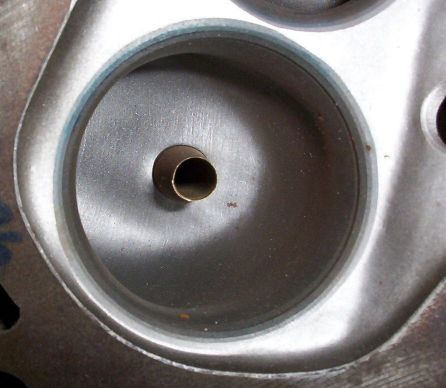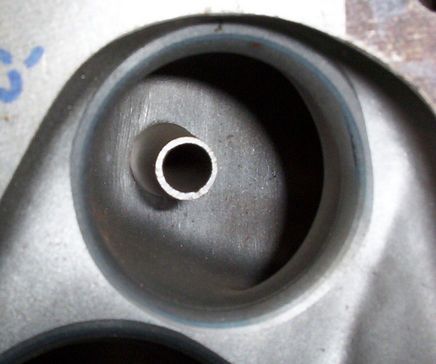Yes Mark, the iron 4V heads have about as much potential as the CHI 3V head. The intake ports are the same height. The 4V port was originally optimized for 0.600" valve lift and 7000 rpm. Remember, the 351C 4V is first and foremost an endurance racing motor, when the 351C was designed, endurance racing motors used camshafts with 0.600" valve lift. The 351C 4V head is still reasonably state of the art at 0.600" valve lift, velocities are higher in modern heads but nothing beats the 4V head for flow potential at that lift.
Intake port

Exhaust port

Match the ports to gaskets, clean up the bowls, 3 angle valve job (5 angle jobs are near impossible to perform due to the combustion chamber), unshrowd the valves in the combustion chamber, reduce the valve guides, open up the roof of the exhaust port, remove the bump (you'll find the exhaust port roof is flat and has a bump in it), and lay back the exhaust port short turn radius. Caution here because its easy to hit water jacket while working the short turn radius.
I advise against any changes in the shape or size (cross section) of the intake port. The Cleveland intake port is designed to swirl the intake column as it flows through the port. Mixture quality was an issue for Ford engineers as far back as the early sixties, and swirling the mixture in the port was their first solution, later replaced by higher port velocity and high swirl combustion chambers. Cleaning up the bowl & the 3 angle valve job will pick up the intake port flow by 50 CFM, from about 275 CFM to 325 CFM at 0.600" valve lift. That's a lot of flow improvement for very little port work.
BTW: The swirling of the intake column withn the intake port is why that large port works as well as it does at low rpm, on street motors. If an over-eager porter ruins the port's ability to swirl the intake column he'll ruin the motor's low rpm response.
Its a whole other story on the exhaust side. The flat roof of the exhaust port and that cast-in bump were put there to bounce the exhaust gases off the roof of the port. There are no exhaust systems to compliment this design, so we hog out that flat surface & bump and make the port work in a more conventional manner. Although the ratio of exhaust gas flow to intake flow is not the textbook "ideal" when measured statically on a flow bench, in practice the Cleveland head has tremendous potential.
The 4V exhaust port is an oddity of the Cleveland design, something we uninformed masses will scratch our heads about forever. Consider that the 2V head was an afterthought, it was designed by the same engineers who designed the 4V head but it has no gas bounce trickery in the exhaust port. The 2V exhaust port out-flows the 4V exhaust port measured in the conventional manner on a flow bench. But the 2V head does not have the same potential as the 4V head. I think the flow bench is a good tool for measuring the results of porting work, or for comparing one head to another, but it does not measure the head under dynamic conditions, with a piston going up and down in the cylinder, valves opening and closing, and combustion taking place etc etc. The engineers at Ford had dynamic potential in mind when they designed the 4V intake and exhaust ports. I guess the exhaust port design just didn't pan out as well as the intake port in real world use.

